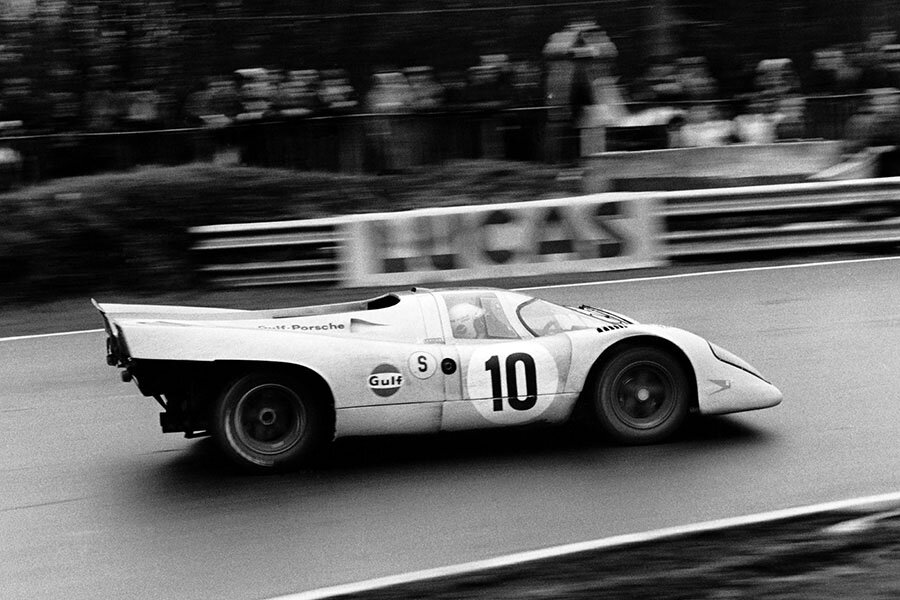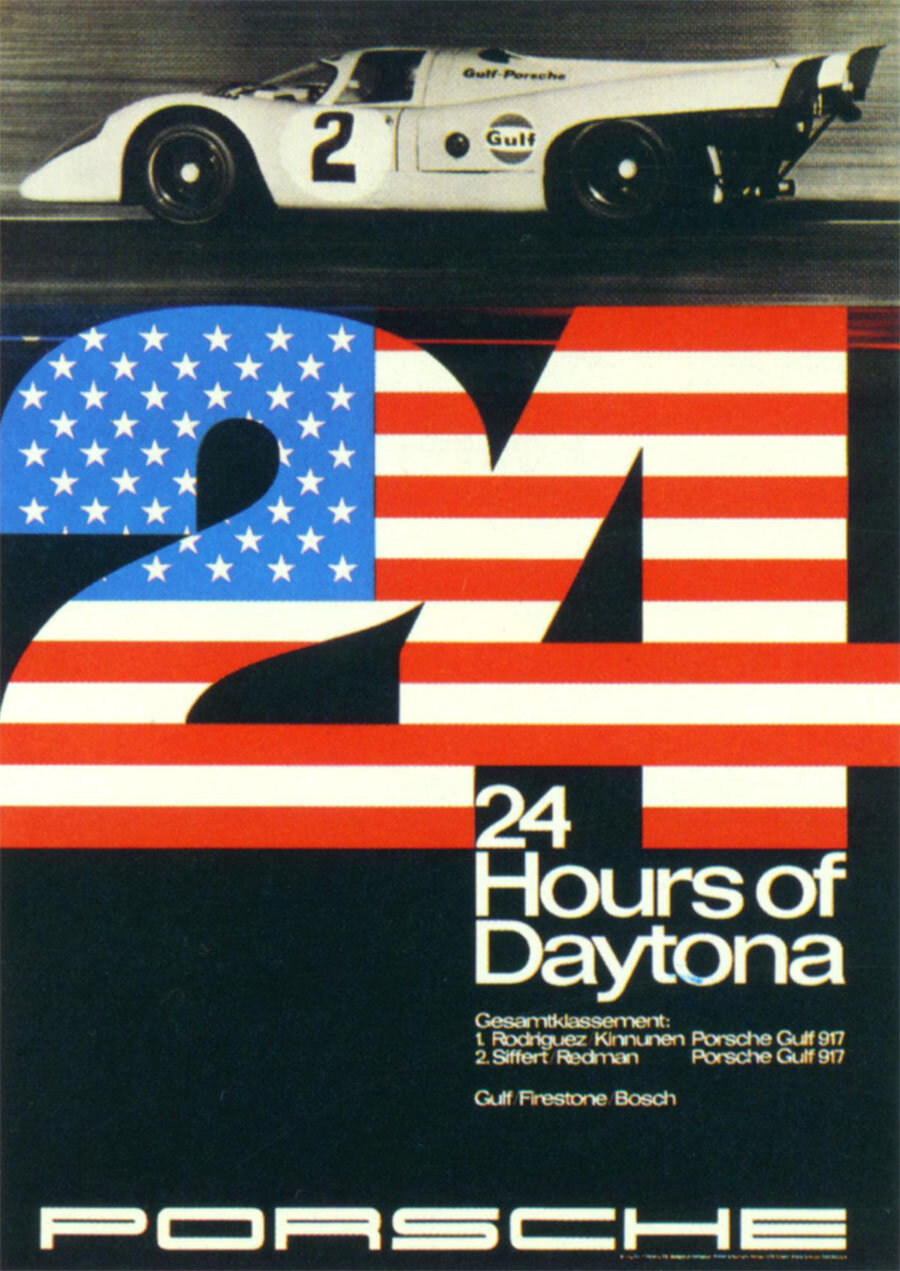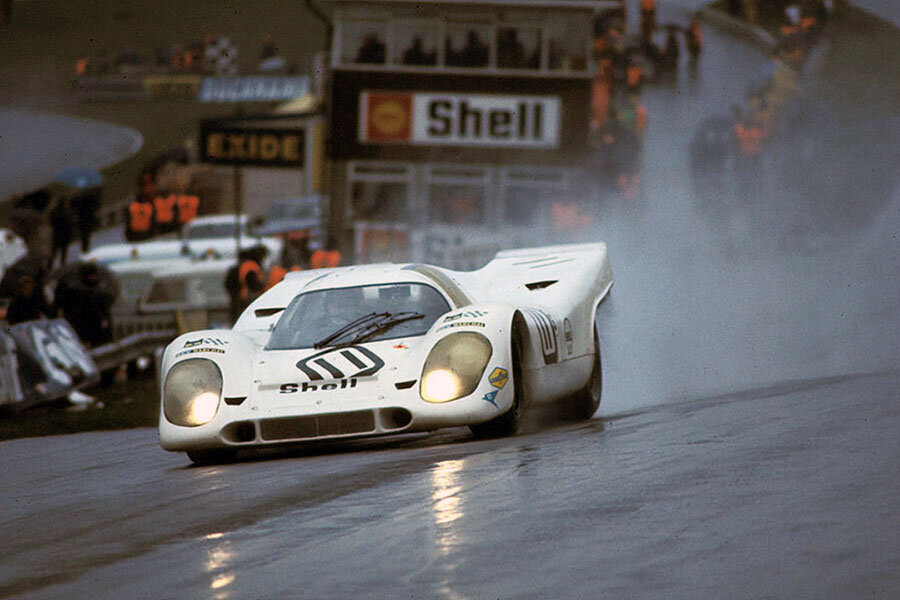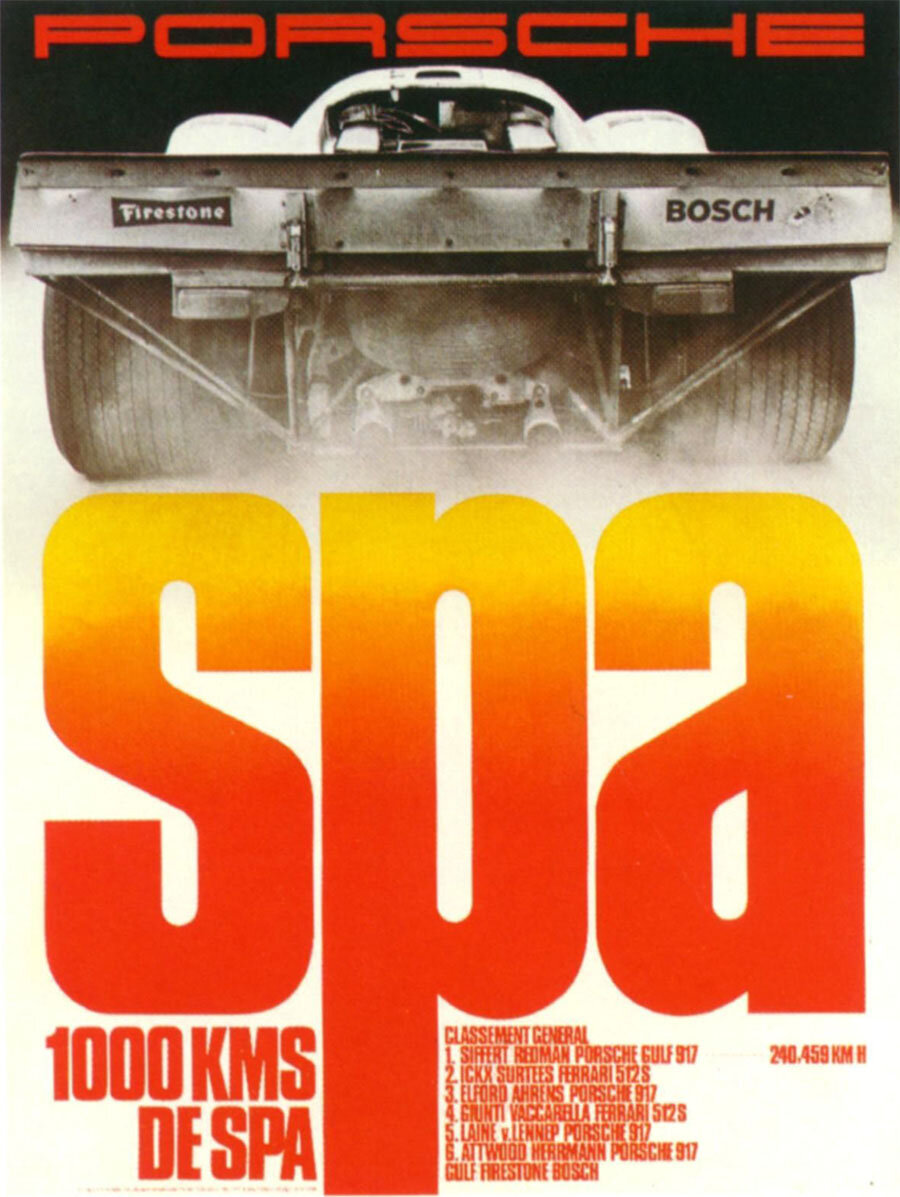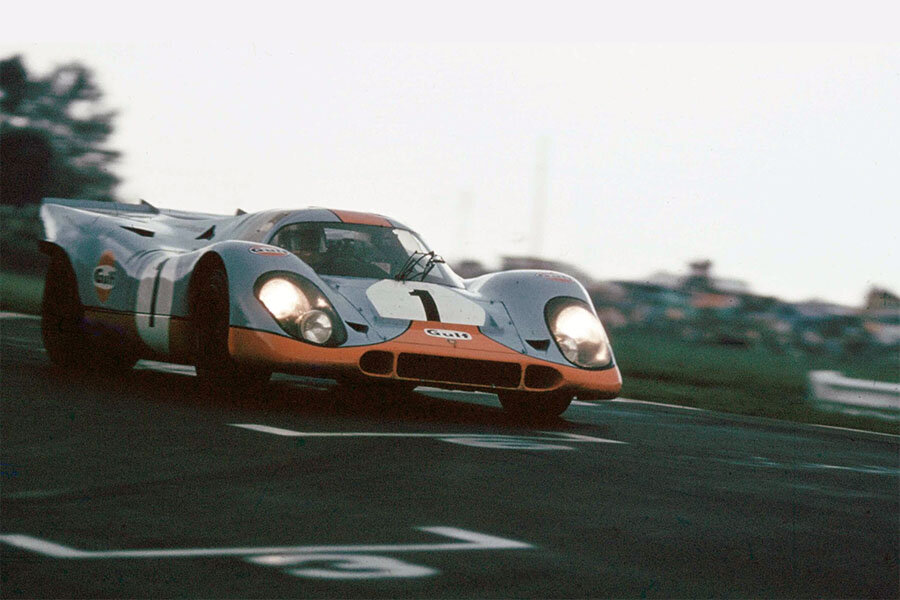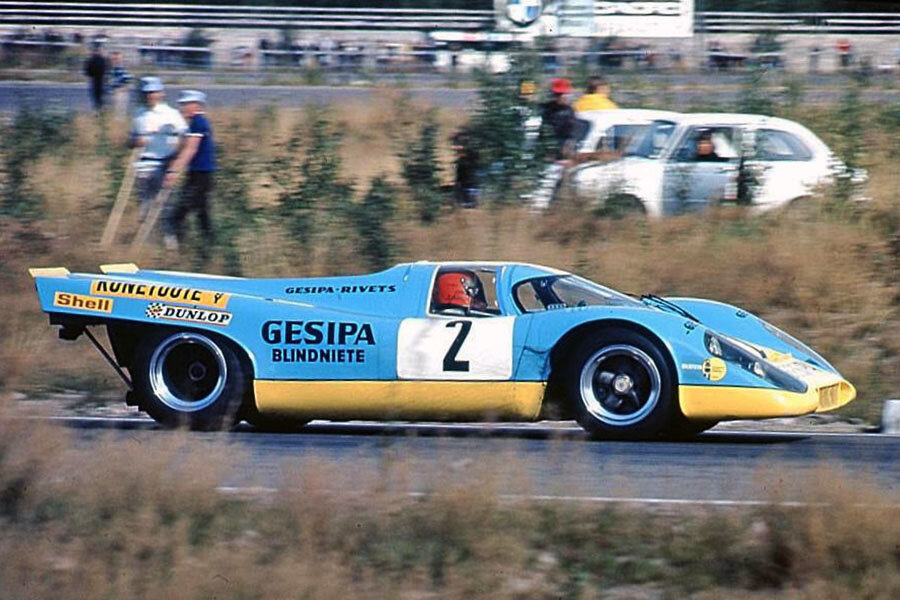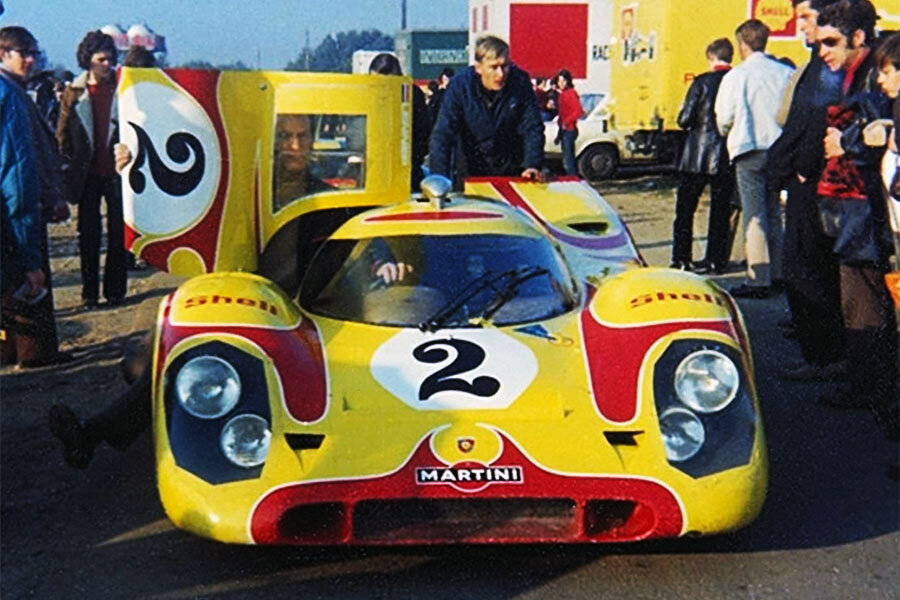Guide: Porsche 917 K / 70 - a Historical & Technical Appraisal
/BACKGROUND
Following back-to-back defeats at Daytona and Sebring in early 1969, Porsche decided they wanted a partner organisation to race their cars. Such a move would enable the factory to focus purely on development.
Just as importantly, Porsche were haemorrhaging vast sums of cash on the combined 908 and as yet still secret 917 programme. A day of reckoning with the accountants was inevitable so, to protect their motor racing activities, Porsche enlisted John Wyer Automotive Engineering (JWAE) whose Gulf Oil-backed operation was the best in the business.
Having worked as Aston Martin’s team manager for David Brown, John Wyer left to set up Ford Advanced Vehicles (FAV) and masterminded the enormously successful GT40 programme. From his base at the old FAV works in Slough, Wyer’s 40-man operation included team manager, David Yorke, deputy managing director, John Horsman, and head mechanic, Ermanno Cuoghi.
At Sebring, Porsche held secret meetings with Wyer and Gulf executive, Grady Davis, to flesh out a potential arrangement.
After the 1969 Spa 1000km race in May, Wyer and Davis flew to Stuttgart to meet Ferdinand Piech and Ferry Porsche where an agreement was signed that, for 1970 and 1971, would put the full 917 project at John Wyer’s disposal.
Wyer got the cars at no cost but, from the moment everything left Stuttgart, it was at JWAE’s expense. JWAE were responsible for preparation and servicing but blown engines would be rebuilt by Porsche back at the factory.
The 917s would race in Gulf colours and driver salaries were split between the two firms; Jo Siffert and Brian Redman were paid by Porsche, Pedro Rodriguez and Leo Kinnunen by JWAE.
When the agreement was signed, John Wyer understood his team would have the only factory-backed Porsches racing. However, still hungry for competition, a frustrated Ferdinand Piech began racing quasi works 917s through his mother’s Austrian import distributorship, Porsche Konstruktionen Salzburg. Factory drivers Kurt Ahrens Jr., Vic Elford, Rudi Lins and Hans Herrmann were employed and the first John Wyer knew of the Salzburg operation was when they turned up for the season opener at Daytona.
Porsche and JWAE went public with the news of their partnership in October 1969, soon after the that year’s World Sportscar Championship had concluded. JWAE’s most pressing issue was to resolve the 917’s chronic handling and stability problems.
A test session was organised at Zeltweg in early October to which Porsche took a 917 Coupe and their new Group 7 Spyder. With its upswept tail but otherwise identical chassis and engine, the Spyder proved around four seconds a lap quicker.
Wyer’s men unceremoniously began cutting away at the Coupe’s back end and improvised a rudimentary new tail using aluminium sheets. Lap times began to drop quickly and the ‘Kurzheck’ was subsequently perfected back in Germany.
BODYWORK
This new configuration, with its bodywork completely cut away from behind the rear wheels up to the height of the tyres, formed the basis for 1970’s much-improved 917 K.
What remained of the upper rear bodywork was extended further back than the Spyder and the original rear windscreen was ditched in favour of an uncovered engine with flying buttresses either side.
Also discarded were the suspension-activated aero flaps.
Changes at the front were less drastic. The familiar looking nose was subtly widened and given enlarged ducts to improve radiator and brake cooling. The winglets used in 1969 were deleted.
CHASSIS
The lightweight tubular alloy gas pressurised spaceframe chassis was unchanged. It was initially still used to pipe oil to the front radiator. However, during the course of 1970, JWAE upgraded to external oil pipes to reduce cockpit heat.
Suspension was via double wishbones, coil springs, adjustable Bilstein dampers and magnesium uprights.
Ventilated disc brakes were fitted, first with ATE and later Girling calipers.
The 15-inch diameter centre-lock five spoke magnesium alloy wheels were once again mounted on titanium hubs. The wheels themselves were widened from 9 to 10.5-inches at the front and from 12 to 15-inches at the back.
Firestone, Dunlop and Goodyear tyres were all used.
ENGINE / TRANSMISSION
Although a 4.9-litre version of the Hans Mezger-designed air-cooled 180° Flat 12 would become available in April 1970, the Type 912/00 4.5-litre units were initially retained but with several enhancements.
The crankcase, which had a reputation for cracking in 1969, was strengthened by deleting the two small inspection hatches where the cracks always started.
A new exhaust system was also added, the old four-pipe arrangement gave way to a neater twin pipe layout.
Mechanical Bosch fuel-injection was retained and, as before, there were two separate ignition distributors feeding the 24 spark plugs.
Compression stayed at 10.5:1 and the 1970 season began with these engines producing 560bhp at 8000rpm.
Regarding the longitudinally mounted all synchromesh transmission, several drivers had complained about the gearchange. With this in mind, the selection was modified to ensure first could only be engaged when the car was at rest.
Four or five-speed gearboxes could be installed depending on circuit characteristics.
WEIGHT / PERFORMANCE
All this led to enormous gains in directional stability albeit at cost to maximum speed: the 917 K topped out at around 190mph, some 30mph less than the Long Tailed 917s had reached at Le Mans in 1969.
TESTING
In the last week of November 1969, JWAE and Porsche went testing at Daytona with the newly finished 1970-spec. Kurzheck. Over the course of a 26 hour session, the 917 Ks proved much more stable and smashed the lap record by nearly seven seconds - an astonishing leap in performance.
The revamped car was officially unveiled during the Porsche Press Day at Hockenheim in early December. JWAE took delivery of their first three 917s that same week – they would use eight during the season.
The Salzberg team would later receive four cars while another five went to privateers.
For 1970, the FIA re-named Group 4 as Group 5.
1970 BUENOS AIRES 1000KM
One of the privateers to race a 917 in 1970 was David Piper whose 1969 car (chassis 010) started the season with a combination of the new Kurzheck rear bodywork and a 1969 nose with its winglets still in place.
Piper flew his car to Argentina at the start of the year to contest the Temporada series. Historically, the Temporada had been a Formula 2 contest but, for 1970, it comprised a pair of sports car races held on different permutations of the Buenos Aires circuit.
The first race was a 1000km event on January 11th.
Piper was joined in his white and green car by factory driver, Brian Redman.
Having qualified on pole, they set the early pace until persistent tyre problems hampered progress. A blowout on on lap 16 was followed by two more rear tyre failures in quick succession. The last of these led to a minor collision with a Lola that put the Porsche out for good.
Jean-Pierre Beltoise and Henri Pescarolo won the race for Matra in a works MS630/650.
1970 BUENOS AIRES 200 MILES
A 200 mile race was held one week later for which Piper drove single-handedly. He qualified sixth but retired early on with gearbox trouble. On this occasion, victory went to the works Alfa Romeo Tipo 33/3 of Piers Courage and Andrea de Adamich.
1970 DAYTONA 24 HOURS
The 1970 World Sportscar Championship kicked off with the Daytona 24 Hours held over January 31st and February 1st. This was also the first race for Ferrari’s new 512 S but, given the 917 K’s performance during those November ‘69 tests, JWAE were confident of beating the Italians.
Four 917s were entered for the race, two from JWAE, one from the Salzburg squad and David Piper’s example that was a late arrival from Argentina. Piper was actually driving for Luigi Chinetti’s Ferrari team at Daytona but Tony Dean’s Porsche 908 had gone astray on its way back from Buenos Aires so Dean arranged to race Piper’s car which was sitting at the docks.
It didn’t arrive until the Thursday afternoon practice session and was under-geared for Daytona which resulted in a blown engine after just a few practice laps. There was no spare so the car, which Dean had expected to share with Gerard Larrousse, failed to start.
JWAE took three Gulf-liveried cars to Daytona, two to race and one for practice. All had Graviner automatic fire extinguishers and an additional window let into the roof for improved visibility on the banking.
Salzburg had one car for Kurt Ahrens Jr. and Vic Elford which was painted white with red air flow flashes.
Both the JWAE and Salzburg cars were running four speed gearboxes.
The Ferrari of Mario Andretti and Arturo Merzario sprang a surprise in qualifying to secure pole. Jo Siffert and Brian Redman started second for JWAE with Pedro Rodriguez / Leo Kinnunen third in the sister car. Ahrens Jr. / Elford lined up fourth for Salzburg.
At 2:10am (a little over eleven hours in), the Salzburg entry of Ahrens Jr. / Elford required a 42 minute pit-stop to fix a petrol tank leak caused by damage from an earlier shock absorber failure. The car did subsequently go out for a few more laps but quickly returned to the pits where it was retired. A few weeks later, this 917 (chassis 011) was destroyed by a mechanic while testing for the Targa Florio.
By contrast, JWAE scored a memorable one-two finish at Daytona and smashed the distance record in the process. Rodriguez and Kinnunen were later joined by Redman in the winning car while the Siffert / Redman entry placed second. Jacky Ickx jumped ship to the Andretti / Merzario Ferrari after his original car retired and they took third for Ferrari.
1970 JARAMA COPA ALFIL
Between Daytona and Sebring, Spanish privateer, Alex Soler-Roig, received his new 917 K (chassis 018).
This plain white car was campaigned under the Escuderia Nacional banner in the 1970 Spanish Sportscar Championship.
Soler-Roig’s first race in the new car came at Jarama on March 1st. He took pole and won convincingly from team-mate Jorge de Bagration’s Porsche 908/02.
1970 SEBRING 12 HOURS
Three weeks later, the World Sportscar Championship headed to Sebring for the 12 Hour race on March 21st.
Four 917 Ks were entered with two each for JWAE and Salzburg.
After six weeks at the Gulf research centre in Pennsylvania, the JWAE cars had new cockpit and damper cooling ducts, improved dampers, larger front wheel bearings, wider wheels and wider bodywork.
The Daytona practice car was entered for Rodriguez / Kinnunen with Siffert / Redman in a refurbished car last raced in 1969. Salzburg had a pair of brand new examples for Ahrens Jr. / Elford (white with blue flashes) and Herrmann / Lins (blue with white flashes).
The Ferrari of Andretti / Merzario took pole with Siffert / Redman second, Ahrens Jr. / Elford third, the Ickx / Schetty Ferrari fourth and Rodriguez / Kinnunen fifth.
Herrmann / Lins started down in eleventh and were the first to retire (with an over-revved engine on lap 28).
The Ahrens Jr. / Elford entry was next to go after 61 laps. Elford was hit by a slower car while trying to avoid another incident. He limped on and had almost made it back to the pits when a wheel came off and tore up the suspension.
The JWAE cars both suffered wobbling uprights as a telegram from Porsche that called for the titanium retaining bolts to be replaced with steel ones had been missed. Multiple changes were required during the race and the problem eventually forced the Siffert / Redman entry to retire.
Rodriguez and Kinnunen (later joined by Siffert) placed fourth.
Victory went to Ferrari’s Ignazio Giunti, Nino Vaccarella and Mario Andretti. Steve McQueen / Peter Revson were second in the Solar Productions Porsche 908/02 and Toine Hezemans / Masten Gregory finished third in a works Alfa Romeo Tipo 33/3.
1970 JARAMA
Three minor races then took place before the next World Sportscar Championship event at Brands Hatch. Alex Soler-Roig won the first which was a minor race at Jarama (March 22nd).
1970 ZOLDER
One week later, the Gesipa Racing Team debuted their 917 K at Zolder non-championship event.
This car (chassis 007) had been raced by the factory in 1969 and rebuilt to 1970 K trim over the winter.
Painted the Gesipa Rivets company colours of blue with yellow stripes, it was raced to a maiden victory at Zolder by Jurgen Neuhaus on March 29th.
1970 THRUXTON EMBASSY TROPHY
The Thruxton Embassy Trophy on March 30th (round two of the British Sports Car Championship) marked the return of David Piper’s car which had by now been fully uprated to 1970 K-spec. complete with a new engine and gearbox.
Painted white, the car was entered for Jo Siffert who only got out in second practice which was wet.
Despite setting a time five seconds faster than anyone else in the wet session, Siffert started from the third row of the grid. Undeterred, he took the lead on lap two and won convincingly from Brian Redman in a works Chevron B16.
1970 LE MANS TEST
On April 11th and 12th, the Le Mans organisers held their annual test weekend. As the date clashed with the World Championship race at Brands Hatch, it was rather poorly attended and wet weather kept lap times down.
JWAE took a brand new car for Mike Hailwood who would be driving for the team at the 24 Hours. Brian Redman also flew out from Brands.
Although the Kurzheck body gave tremendous handling advantages, it paid dearly in terms of top speed. To counter, Porsche had designed a new long tailed body for Le Mans that they hoped would maintain stability on the Mulsanne Straight.
With Kurt Ahrens Jr. having destroyed the first 917 Langheck in a crash at Volkswagen’s Wolfsburg test track the week before (chassis 040), a second example was hurriedly built up (041). It appeared only briefly over the test weekend and was driven by Herbert Linge to 15th fastest time.
By contrast, the Redman / Hailwood 917 K went quickest. Ickx / Giunti / Schetty were second in a works Ferrari 512 S.
1970 BRANDS HATCH 1000KM
The same weekend, Brands Hatch hosted a 1000km race for round three of the 1970 World Sportscar Championship.
Five 917 Ks were entered, two each for JWAE and Salzburg plus David Piper’s car which had now been painted red to reflect sponsorship from Herb Wetson’s hamburger chain. Co-driven by David Hobbs, Piper’s car broke a camshaft in practice so did not start.
After the debacle at Sebring, the troublesome four-stud front hubs on the JWAE cars had been replaced with a stronger single fixing arrangement. Weight had also been reduced a little and the engines were now rated at nearly 570bhp.
A rebuilt 1969 race car was entered for Siffert / Redman while Rodriguez / Kinnunen got a brand new chassis.
The brace of Salzburg cars comprised a brand new plain white example for Vic Elford and Denny Hulme (who was replacing the recovering Ahrens Jr. after his Long Tail testing crash). There was also the blue car used at Sebring with its white airflow flashes for Richard Attwood / Hans Herrmann.
Once again, a Ferrari was on pole (Amon / Merzario) with another 512 S second (Ickx / Oliver). Best of the Porsche entries was Elford / Hulme in third with the Matra MS650 of Brabham and Beltoise fourth. As for the other three 917s, Siffert / Redman were fifth, Rodriguez / Kinnunen seventh and Attwood / Herrmann ninth.
The race was predominantly run in torrential rain, but Porsche emerged victorious in the slippery conditions and 917s filled the top three positions.
Having been demoted to fifth while leading for passing under yellow flags, Pedro Rodriguez put on an incredible display of wet weather driving and was simply uncatchable.
Elford / Hulme and Attwood / Herrmann rounded out the podium for Salzburg while Redman slithered off the track and crashed under pressure from Amon while lying second. This car (004) was subsequently rebuilt with a new chassis for Spa (017) but continued to race with the identity of 004.
1970 MONZA TESTS
One week before the Monza 1000km took place on April 25th, Porsche tested a 4.9-litre version of the Flat 12 engine at the Italian circuit. An engine of up to five-litres had been homologated at the end of 1969. Herrmann, Elford and Kinnunen covered a full race distance without any problems.
Outwardly similar to the 4.5-litre unit, the new Type 912/10 engine displaced 4907cc. This was achieved by taking the bore out from 85mm to 86mm and extending the stroke from 66m to 70.4mm. A new crankshaft and rods were fitted but compression stayed at 10.5:1.
These 4.9-litre units started out with 570bhp at 8100rpm but 600bhp at 8400rpm was expected down the line. Two engines would be available for the race at Monza in one week’s time.
1970 MONZA 1000KM
No less than seven 917 Ks were entered at Monza. There were two each for JWAE and Salzburg plus David Piper’s Wetson’s backed car (with another new engine) and the blue and yellow Gesipa machine. There was also a brand new Shell-backed car (021) painted yellow with red lower trim. This car was entered by the AAW Racing Team run by Finnish industrialist, Antii Aarnio-Wihuri.
JWAE ran the 4.9-litre engine for Siffert / Redman and a 4.5 in the Rodriguez / Kinnunen entry.
Salzburg had their plain white car for Elford / Ahrens Jr. (4.9) and their blue with white airflow flashed example for Herrmann / Attwood (4.5).
All four of these cars had a new Girling brake system that used Ford GT40-type front calipers with ventilated discs. To accommodate this new arrangement, special front uprights had been made in Stuttgart.
Siffert / Redman were on pole in the 4.9-litre Gulf entry but an oil leak late in the session saw them revert to a 4.5 for the race. Amon / Merzario started second for Ferrari with Elford / Ahrens Jr. third in the Salzburg 4.9. Giunti / Vaccarella were fourth in another Ferrari, Rodriguez / Kinnunen fifth for JWAE and the Surtees / Schetty 512 S sixth. Gesipa, the second Salzburg entry and AAW were seventh, eighth and ninth respectively. David Piper’s car started down in 17th.
The victorious Rodriguez / Kinnunen 917 saved the day for Porsche after all the other works-assisted examples had problems.
Siffert was forced to spin at Lesmo to avoid a slower car and touched a barrier which necessitated a 24 minute stop for new rear suspension. This car finished twelfth.
A few laps after Siffert’s incident, the Attwood / Herrmann entry went out when the engine was over-revved.
In the sister Salzburg car, Ahrens Jr. retired from the lead after a tyre blowout smashed the oil tank, ripped off most of the left hand rear wing and damaged the suspension.
The AAW car of Gijs van Lennep and Hans Laine touched a barrier on the opening lap and it took two stops to properly cut away the damaged bodywork. They eventually finished eleventh, one position behind the Gesipa entry of Jurgen Neuhaus and Helmut Kelleners.
The David Piper / Tony Adamowicz 917 went out with a seized gearbox at around one third distance.
1970 TARGA FLORIO
On May 3rd, the Targa Florio hosted round five of the World Sportscar Championship.
For the twisty road course, Porsche produced their latest version of the three-litre 908 Spyder: the 908/03.
JWAE and Salzburg both preferred the 908/03 to the unwieldy 917s and it was the Gulf-backed squad that finished first and second.
Salzburg had taken their blue and white striped 917 K to Sicily and Elford did try a few practice laps in the car but quickly decided against any more.
1970 JARAMA
The same day as the Targa Florio, Alex Soler-Roig took another domestic Spanish championship win in chassis 018 at Jarama.
1970 FASSBERG
A week later, a non-championship race at Fassberg was expected to see three 917s race. However, the Porsche Salzburg entry never materialised after their transporter crashed en route.
Gesipa decided to run their 908/02 due to a lack of spare engine parts for the 917.
That left David Piper as the sole 917 representative.
After qualifying second (behind Teddy Pilette’s Lola T70 Mk3B GT), Piper lost control early on. He hit a straw bale at the chicane hard enough to damage the front end which forced him out of the race.
1970 SPA 1000KM
May 17th saw the World Championship head to Spa for another 1000km race.
JWAE arrived with two 4.9-litre cars for Rodriguez / Kinnunen and Redman / Siffert. The Salzburg team also had their plain white 4.9-litre car for Elford / Ahrens Jr. plus the older blue and white striped 4.5-litre example for Attwood / Herrmann.
Additionally, the yellow and red AAW car was on hand for Laine / van Lennep (complete with new 4.5-litre engine) plus the blue and yellow Gesipa entry for Neuhaus / Kelleners.
JWAE experimented with 12.5-inch wide front wheels in practice but struggled with tyre blowouts so reverted back to the 10.5-inch rims instead.
The Rodriguez / Kinnunen Porsche took pole with Siffert / Redman second and the Ickx / Surtees Ferrari third. Gesipa had their best qualifying session of the season with Neuhaus / Kelleners fourth. AAW were sixth and the Salzburg entries eighth (Attwood / Herrmann) and twelfth (Elford / Ahres Jr.).
The Kinnunen / Rodriguez entry went out with a seized gearbox after 44 laps when lying second but, thanks to Siffert and Redman, JWAE took their fifth win of the year. Ickx and Surtees were second in a Ferrari with the 4.9-litre Salzburg 917 of Elford / Ahrens Jr. third.
Hans Laine and Gijs van Lennep placed fifth behind the Giunti / Vaccarella 512 S with Attwood / Herrmann sixth for Salzburg.
The only other non-finishing 917 was the Gesipa entry that retired after Neuhaus hit Andre Wicky’s Porsche and took both cars out. Thankfully, neither vehicle was seriously damaged.
1970 NURBURGRING 1000KM
Like at the Targa Florio, the Nurburgring 1000km race on May 31st (round seven) saw the JWAE and Salzburg teams run 908/03s.
AAW’s top drivers, Laine and van Lennep, also preferred their team’s older but more nimble 908/02 so Pauli Toivonen and Sten Axelsson were entered in the 917.
Unfortunately, just before the end of Saturday practice, Hans Laine crashed the AAW 908 down the straight having got airborne over a bump after losing a spoiler. Tragically, Laine was trapped underneath the car which then caught fire and burned uncontrollably for many minutes.
Hans Laine suffered a most gruesome death and naturally the AAW 917 was withdrawn from the race.
Neuhaus and Kelleners had qualified the Gesipa entry ninth but retired after nine laps with a broken wheel bearing. The wheel had actually come off in the South Curve and, although Kelleners got it back on and limped round to the pits, the car was pushed away.
The Salzburg crew took their first win of the year with the 908/03 of Elford / Ahrens Jr. finishing ahead of Herrmann / Attwood’s sister car in second. Neither of the Gulf 908/03s made it to the end.
1970 JARAMA TROFEO POR REGIONES
That same weekend, Alex Soler-Roig won another Spanish championship event, the Jarama Trofeo por Regiones, in his Escuderia Nacional car.
1970 DIJON
A week later, David Piper entered his red 917 for a non-championship race at Dijon where he finished second to Richard Attwood who won in Piper’s Lola T70 Mk3B GT.
1970 LE MANS 24 HOURS
Next up was the biggest event in motor racing, the Le Mans 24 Hours, which took place over June 13th and 14th.
For this, round eight of the World Sportscar Championship, John Wyer opted not to run the largely unproven Langheck. The long tailed 917 had proven unstable in fast corners and prone to aquaplaning in the wet: two had already been destroyed in testing accidents.
Instead, JWAE arrived for Le Mans with several upgrades to their 917 Ks. One of the modifications was a small spoiler located in the central section of the rear bodywork’s trailing edge. This increased downforce and meant less aggressive angles for the other rear spoilers were required. JWAE had also trialled an F1-style wing mounted above the engine as part of their pre-Le Mans aero tests back in England.
Other upgrades included two batteries, two alternators and two starter motors (all specially developed by Bosch). There were also quick-change headlamp units, strengthened front wings plus a thicker front and thinner rear anti-roll bar. Separate oil pipes were introduced by JWAE as the existing arrangement (where the chassis tubes carried the oil) had made the cockpit too hot.
Both the JWAE and Salzburg cars also got strengthened gearboxes plus new uprights that had been modified to better suit the Girling brakes.
Seven 917s were entered for the race including two Langhecks, one of which was painted white with red airflow flashes for the Salzburg pairing of Ahrens Jr. / Elford. The other was a Martini-backed entry run by Porsche themselves for Gerard Larrousse and Willi Kauhsen. This factory car was painted purple with psychedelic white and green stripes. Both these 917 Ls ran 4.5-litre engines and five-speed gearboxes.
The Salzburg crew also had a 4.5-litre 917 K painted orange with white flashes for Attwood / Herrmann.
JWAE arrived with a trio of Kurzhecks for Siffert / Redman (4.9), Rodriguez / Kinnunen (4.9) and a brand new car for Hobbs / Hailwood (4.5). All three used the four-speed transmission.
One privateer 917 K was also on hand: the yellow and red AAW machine which had been specially prepared for Le Mans by Porsche themselves. After the death of Hans Laine, Gijs van Lennep was joined by David Piper who brought sponsorship from drinks firm, Sandeman.
For Le Mans, Ferrari had designed long tail rear body sections for the 512 S.
Qualifying was closely fought.
Elford and Ahrens Jr. took pole in the white and red Salzburg 917 L followed by the works Ferrari of Vaccarella / Giunti. Siffert and Redman started third in their JWAE 917 K. Then came another factory 512 S (Merzario / Regazzoni) and the sister JWAE car of Rodriguez / Kinnunen in fifth.
Hailwood and Hobbs were tenth in the new 4.5-litre Gulf 917 K followed by Piper / van Lennep in eleventh for AAW. Larrousse / Kauhsen started twelfth in the Martini Langheck and Attwood / Herrmann lined up 15th in the orange and white Salzburg 917 K.
Only two of the seven 917s finished the race.
First to retire was the Gulf 917 K of Rodriguez / Kinnunen which stopped at Arnage after 22 laps with a broken con rod.
Next out was the sister car of Hailwood / Hobbs on lap 49; Hailwood smashed into a recently stopped Alfa 33 when fighting for control in slippery conditions. This car (chassis 026) was rebuilt with a new chassis (031) but continued to race with the identity of 026.
The AAW entry was retired after 122 laps. David Piper had been off and damaged the front bodywork when lying third. It was mended back at the pits but the crash had knocked the wheels out of alignment and, shortly after Gijs van Lennep went back out, a tyre blew at 180mph. The debris tore through the wing and that was that for the AAW crew.
While holding a seven lap lead, Siffert missed a gear at 2am on Sunday in the last remaining JWAE entry. He came into the pits with oil pouring from the exhaust pipes; the engine had been over-revved to 9600rpm.
Just three 917s remained.
Having led convincingly after the Siffert / Redman Gulf entry retired, the white and red Salzburg Langheck began to experience handling problems. It turned out to be a slow puncture. When lying second at 8:30am, the engine broke an inlet valve and the car was retired.
Thankfully, the other two 917s went the distance.
Attwood and Herrmann, who had been slowest in qualifying, came through to win by five laps from the purple and green Martini long tail of Larrousse and Kauhsen.
The Martini car had been delayed by wet weather affecting the electrics but to Porsche it mattered not as their maiden victory in the Le Mans 24 Hours had finally been secured.
1970 MONTLHERY COUPES DE L’ACIF / MAINZ-FINTHEN INTERNATIONAL
On June 21st, David Piper finished second driving his red Sandeman-backed 917 in the ACIF Cup at Montlhery.
The same day, Jurgen Neuhaus won the Mainz-Finthen International meeting for Gesipa.
1970 NORISRING INTERSERIE
One week later, the opening round of a new competition was held at the Norisring.
The Interserie championship was Europe’s answer to Can-Am and permitted cars from Groups 5, 6 and 7 to participate.
AAW were on hand with a new 917 K. After the damage sustained at Le Mans, it had been quicker to give the old car (021) a new chassis (012). This new chassis raced on with the identity of 021 for carnet reasons.
The old damaged chassis (021) was repaired and later used for AAW’s 1971 Group 7 Spyder. It was re-numbered 01-021 in the process.
012 turned up at the Norisring looking quite tatty with the original car’s yellow tail section and primered panels everywhere else.
Gijs van Lennep qualified second behind the Racing Team VDS Lola T70 Mk3B GT of Teddy Pilette. Jurgen Neuhaus started sixth in the blue and yellow Gesipa 917.
Neuhaus won the race with van Lennep second and Pedro Rodriguez third in the Sports Cars Brostrom Porsche 908/02.
1970 HOCKENHEIM INTERSERIE
Hockenheim hosted the second Interserie race a week later.
This time there were four 917 Ks in attendance, all of which were still using 4.5-litre engines as there was proving to be a shortage of fresh motors and long rebuild times at Porsche.
Having looked decidedly dog-eared at the Norisring, the AAW entry had been repainted a similar purple and psychedelic green to the 917 L that finished second at Le Mans. The new colour scheme reflected its forthcoming appearance at Watkins Glen where it was to be sponsored by Martini.
Pole went to the Auto Zeitung-backed March 707 of Helmut Kelleners. Van Lennep started fourth for AAW, Neuhaus was fifth for Gesipa and David Piper sixth.
Qualifying down in 13th was a new plain white 917 K (chassis 025) that had been purchased by Bolivian industrialist, Jaime Ortiz-Patino, for his godson, Dominique Martin. Campaigned under the Zitro Racing banner, Martin finished the race eleventh.
At the sharp end, Vic Elford won in the Paul Watson McLaren M6B with van Lennep second for AAW. Piper was fourth and Neuhaus sixth.
1970 CROFT INTERSERIE
Interserie round three took place at the Croft circuit in England one week later but for this event, only Jurgen Neuhaus showed up with the Gesipa 917 (now fitted with ATE brakes).
After qualifying third behind the Team Evergreen McLaren M8C of Chris Craft and the Auto Zeitung March 707 of Helmut Kelleners, Neuhaus moved up to finish second in the race when Craft span out.
1970 WATKINS GLEN 6 HOURS
That same weekend, World Championship racing resumed with the Watkins Glen 6 Hours in New York state. This was round nine of ten and a good result would see Porsche take the title.
JWAE were on hand with a pair of Gulf-backed entries for Siffert / Redman and Rodriguez / Kinnunen. These cars arrived with wider wheels and bodies plus the additional rear spoiler used at Le Mans.
The Salzburg squad were also present and appeared under the Porsche+Audi banner. Two blue cars with white flashes were entered, a darker blue example for Elford / Hulme and the lighter blue one for Attwood / Ahrens.
Present too was the Martini-backed AAW car which had been painted purple and green to mimic the 917 L that finished second at Le Mans. This car still had a 4.5-litre engine whilst all the others were running 4.9s.
Siffert and Redman were on pole with the Ferrari 512 S of Andretti / Giunti second and Rodriguez / Kinnunen third. Ickx / Schetty were fourth for Ferrari followed by van Lennep / Larrousse fifth for AAW-Martini. Then came the Salzburg entries of Attwood / Ahrens Jr. in sixth and Elford / Hulme seventh.
Team-mates Siffert and Rodriguez banged wheels in the opening stages but eventually took a commanding one-two for JWAE.
Rodriguez / Kinnunen emerged victorious with Siffert / Redman second.
Both Salzburg cars struggled with chunking tyres. The Elford / Hulme entry placed fourth behind a works Ferrari 512 S with Attwood / Ahrens Jr. sixth. Back in ninth was the Martini-backed AAW entry of van Lennep / Larrousse.
Porsche won the 1970 World Championship with one event still to run.
1970 WATKINS GLEN CAN-AM
The following day, Watkins Glen played host to round three of the Can-Am championship and, given the substantial prize fund on offer, it was no surprise that all the 917s were wheeled out despite being up against more-fancied Group 7 opposition.
JWAE ran their two race cars plus the spare.
Although in qualifying they were not able to match the outright speed of the works McLaren M8Ds (or many of the Group 7 cars for that matter), the Porsches put on a very good show in the race.
Denny Hulme won for McLaren while in the 917s, Siffert was second, Attwood third, Elford fourth, van Lennep sixth and Redman seventh.
The only non finisher was Pedro Rodriguez who retired at one third distance with a broken gearbox.
1970 MAGNY COURS
On July 14th, David Piper was classified third driving his red Sandeman and Wetson’s-backed 917 in a non-championship race at Magny Cours.
He finished behind Jean-Pierre Beltoise who was driving Piper’s Lola T70 Mk3B GT and David Prophet’s McLaren M12.
1970 SWEDISH GP, KARLSKOGA
The Karlskoga circuit in Sweden then hosted the Swedish GP on August 9th but this most prestigious event was run under a cloud after a major accident earlier in proceedings. Two saloon cars had touched in a fast left hander and rolled end over end for 50 yards leaping across the safety bank and into the crowd. Five spectators were killed and 27 more injured.
The Finnish AAW squad were in attendance with their purple and green car for Gijs van Lennep along with David Piper, but the 917s were not really suited to such a tight circuit and finished fourth and sixth respectively.
Chris Craft won in the Ecurie Evergreen McLaren M8C followed by Helmut Marko in a Porsche 908/02. Jo Bonnier’s was third in his Lola T210.
1970 WUNSTORF
A contest for prototype and sports racing cars at the Wunstorf airfield track on August 16th saw Jurgen Neuhaus take second for the Gesipa Racing Team. Helmut Kelleners won in the Auto Zeitung-backed March 707.
1970 KEIMOLA INTERSERIE
One week later, Neuhaus was out again, this time to defend his Interserie championship lead at Keimola in Finland.
David Piper was also present along with AAW for a rare outing on home soil. AAW’s car (chassis 012) had by this time been repainted yellow with red psychedelic stripes.
Neuhaus started from pole for Gesipa with van Lennep second for AAW and Piper back in seventh where he finished the race. Gijs van Lennep took the win for AAW and Neuhaus claimed the runner up spot.
FILMING FOR THE SOLAR PRODUCTIONS MOVIE LE MANS
The Keimola race would prove to be David Piper’s final professional drive.
A few days later, he broke his leg in three places along with two bones in his foot during a nasty accident while shooting for the Steve McQueen film Le Mans.
Piper had been instrumental in helping Solar Productions source cars for the movie but lost control at high speed in the fast Maison Blanche kink near where John Woolfe had perished the previous year.
The car (a JWAE supplied 917 K, chassis 013) was completely destroyed.
Piper ultimately lost his leg. He would continue as an entrant but his top flight driving career was over.
1970 ALCANIZ
On September 6th, Alex Soler-Roig secured the Spanish Sportscar Championship with a win at Alcaniz.
1970 IMOLA 500KM
A week later, the non-championship 500km race at Imola attracted a very strong entry including two 917 Ks from JWAE and the Zitro Racing example which now looked very smart painted white with blue stripes.
For this race, Dominique Martin was joined by Nino Vaccarella but, after qualifying sixth, a slow puncture caused the Italian to crash out and crunch the car’s nose.
The 4.9-litre JWAE 917s started second and third behind the Escuderia Montjuich Ferrari 512 S.
The Porsche of Pedro Rodriguez was eliminated trying to avoid a spinning Chevron while Redman’s 917 had an easy win in the sister car.
1970 ZANDVOORT DUNES TROPHY
The annual Dunes Trophy at Zandvoort followed on September 20th and, although the date clashed with the Thruxton Interserie race, AAW opted to attend the Dutch event.
In its fabulous yellow and red psychedelic colour scheme (and still with a 4.5-litre engine) Gijs van Lennep started on pole in the AAW entry and won the race from Helmut Kelleners in his March 707.
1970 THRUXTON INTERSERIE
At Thruxton, against a thin field, championship leader Jurgen Neuhaus took pole and won for Gesipa to give himself a practically unassailable lead in the Interserie standings.
1970 MONTLHERY COUPES DU SALON
One week before the World Championship wrapped up at Zeltweg, the Coupes du Salon was held Montlhery.
Zitro Racing had their best result of the year at this event. Driving solo in his immaculately repaired car after its crash at Imola three weeks earlier, Dominic Martin qualified second and finished third behind Jose Juncadella’s Escuderia Montjuich Ferrari 512 S and the winning Porsche 908/02 of Gerard Larrousse.
1970 ZELTWEG 1000KM
Despite the championship having already been decided in Porsche’s favour, there was still a very healthy entry for the Zeltweg 1000km on October 11th.
Making its debut was the updated Ferrari 512 ‘M’ which qualified second.
JWAE took two cars. The Rodriguez / Kinnunen 917 started on pole with the Siffert / Redman entry fifth behind the pair of Salzburg machines of Ahrens Jr. / Marko (blue with white flashes) and Elford / Attwood (orange with white flashes).
This would be the last race for the Salzburg operation as their cars were being leased to Hans Dieter Dechent’s Martini International Racing Team for 1971.
Rodriguez was forced to pit on lap five and retired with broken exhaust valves. Ahrens later ran out of fuel when leading. The Elford / Attwood entry was slowed by a broken oil cooler and stopped eight laps from the end but had covered sufficient distance to be classified fourth.
Siffert / Redman won the race but, for the last half hour, their car was running very rough having suffered a partial camshaft failure.
1970 WORLD SPORTSCAR CHAMPIONSHIP STANDINGS
Zeltweg capped off an enormously successful season for Porsche.
John Wyer’s team had won seven of the ten World Championship races in 1970 (once with the 908/03) while the Salzburg crew took victory at Le Mans and the Targa Florio (with a 908/03).
Porsche finished the year on 63 points to Ferrari’s 37.
1970 HOCKENHEIM INTERSERIE
Also ending on October 11th was the inaugural Interserie championship which fell to Porsche driver Jurgen Neuhaus in the blue and yellow Gesipa Racing Team entry.
Neuhaus placed second in the race at Hockenheim behind the March 707 of Helmut Kelleners while Gijs van Lennep took third for the AAW squad. Dominique Martin failed to start.
1970 PARIS 1000KM, MONTLHERY
For the non championship Paris 1000km race held at Montlhery on October 18th, the yellow and red AAW machine had a brand new engine and further backing from Martini. Gerard Larrousse partnered Gijs van Lennep and they qualified second behind the Matra MS660 of Jean-Pierre Beltoise / Henri Pescarolo.
In the Gesipa entry, Jurgen Neuhaus was joined by Porsche’s new test driver, Willi Kauhsen, and they lined up third.
Dominique Martin was once again co-driven by Nino Vaccarella in the white and blue Zitro entry but Vaccarella blew the engine during practice (the motor dropped a valve and holed a piston).
The race was disappointing for the remaining Porsches. Van Lennep retired after 17 laps with a bent valve while, 30 laps from the finish when lying fourth, Kauhsen had a monumental accident at the Farm which wrote off the Gesipa 917. Kauhsen fortunately escaped unhurt.
The car (chassis 007) was retained by Gesipa and rebuilt by Porsche into a Group 7 Spyder to contest the 1971 Interserie championship.
Jack Brabham and Francois Cevert took victory for Matra. The Escuderia Montjuich Ferrari 512 S of Jose Juncadella / Jean-Pierre Jabouille finished second.
1970 KYALAMI 9 HOURS
The final big race of 1970 took place in South Africa as part of the Springbok winter series. A nine hour race at Kyalami on November 11th kicked things off.
The yellow and red Martini-backed AAW machine was entered for factory drivers, Jo Siffert and Kurt Ahrens Jr., while David Piper’s car was on hand for John Love and Richard Attwood. Painted orange with brown stripes to reflect backing from Gunston tobacco, this car qualified third behind the AAW / Martini entry and Ferrari’s pole starting 512 M which was being driven by Jacky Ickx and Ignazio Giunti.
After a year of Porsche domination, Ferrari won from Siffert and Ahrens Jr.
Sadly, it wasn’t enough to convince the Italian firm not to abandon their works involvement with the 512 in 1971.
David Piper’s car was retired from the Kyalami race with a split fuel header tank.
Text copyright: Supercar Nostalgia
Photo copyright: Porsche - https://www.porsche.com


